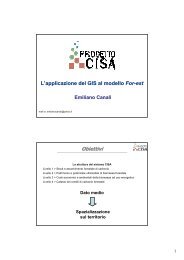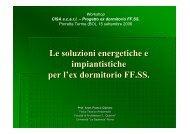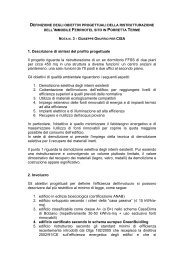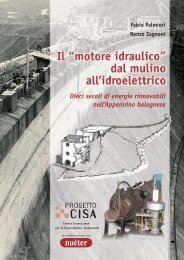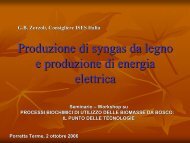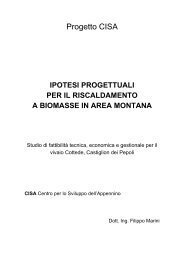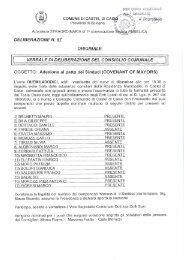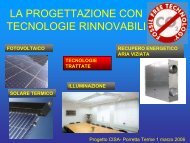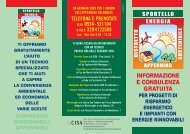Le linee guida per la contabilizzazione delle riduzione di CO2 degli ...
Le linee guida per la contabilizzazione delle riduzione di CO2 degli ...
Le linee guida per la contabilizzazione delle riduzione di CO2 degli ...
You also want an ePaper? Increase the reach of your titles
YUMPU automatically turns print PDFs into web optimized ePapers that Google loves.
Verso Copenhagen: <strong>linee</strong> <strong>guida</strong> <strong>per</strong> <strong>la</strong> <strong>contabilizzazione</strong> <strong>delle</strong> riduzioni <strong>di</strong> <strong>CO2</strong> <strong>degli</strong> enti locali 73<br />
ALLEGATO 1<br />
NORMATIVE TECNICHE E CARATTERISTICHE COSTRUTTIVE DA RISPETTARE<br />
L’instal<strong>la</strong>zione dei semafori devono rispettare <strong>la</strong> normativa EN 12368 secondo <strong>la</strong> quale:<br />
Intensità luminosa<br />
A 2/1 (> 300 cd)<br />
Distribuzione intensità luminosa<br />
C<strong>la</strong>sse W<br />
Uniformità luminosa Lmin/Lmax ≥ 0,1<br />
Massimo effetto phantom C<strong>la</strong>sse 1<br />
Resistenza all’impatto IR 1<br />
Grado <strong>di</strong> protezione IP 55<br />
C<strong>la</strong>sse ambientale<br />
B<br />
Nel calcolo <strong>di</strong> RLS si è tenuto conto <strong>di</strong> un funzionamento continuo <strong>di</strong> 24 h al giorno <strong>per</strong> tutto l’anno (365 giorni),<br />
mentre <strong>per</strong> le caratteristiche dei <strong>Le</strong>d si è fatto riferimento ai seguenti dati:<br />
<strong>Le</strong>d <strong>di</strong> tipo High Flux<br />
Numero <strong>di</strong> 18 led <strong>per</strong> i moduli semaforici rosso e giallo (200 e 300 mm)<br />
Numero <strong>di</strong> 12 led <strong>per</strong> i moduli semaforici ver<strong>di</strong> (200 e 300 mm)<br />
(Fonte: Ditta produttrice SEMAFORICA scn)<br />
ALLEGATO 2<br />
TABELLA COMPLETA DEL RISPARMIO ENERGETICO<br />
Potenza<br />
LANTERNA<br />
incandescenza<br />
= Pi [W]<br />
Potenza<br />
LANTERNA<br />
LED<br />
Pled [W]<br />
Differenza<br />
∆P = Pi-Pf<br />
[W]<br />
Utilizzo<br />
h<br />
[ore/anno]<br />
Risparmio<br />
energia<br />
∆E = ∆P∙h<br />
[kWh/anno]<br />
Differenza<br />
% risparmio<br />
energia<br />
Risparmio energia<br />
in tep<br />
∆Et = ∆E∙0,187∙10 -3<br />
[tep/anno∙<strong>la</strong>mpada]<br />
Risparmio energia<br />
in tep<br />
∆Et = ∆E∙0,187<br />
[tep∙10 -3<br />
/anno/<strong>la</strong>mpada]<br />
70 13 57 8760 499,32 81,43% 0,093313 93,37<br />
80 15 65 8760 569,4 81,25% 0,106477 106,47<br />
100 18 82 8760 718,32 82,00% 0,134325 134,32<br />
... ... ... ... ... ... ... ...<br />
NB. Qualora i dati a <strong>di</strong>sposizione facessero riferimento a potenze non presenti nell'allegato 2, è sufficiente<br />
calco<strong>la</strong>re il coefficiente RLS re<strong>la</strong>tivo.<br />
Nel caso <strong>di</strong> rosso maggiorato con <strong>la</strong>mpade 100-70-70, <strong>la</strong> me<strong>di</strong>a <strong>delle</strong> 3 <strong>la</strong>mpade che compongono <strong>la</strong> <strong>la</strong>nterna è<br />
80 W. Utilizzare il valore corrispondente <strong>per</strong> il calcolo RLS.



